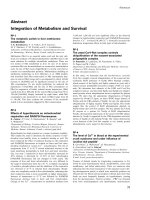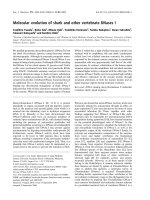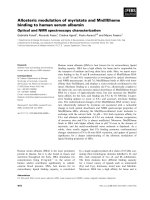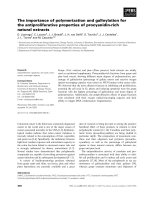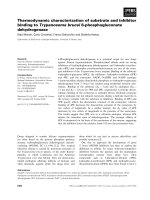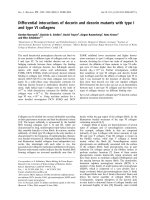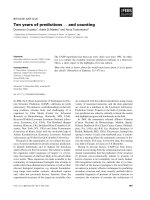Báo cáo khoa học: " SemiNeo-adjuvant chemo-radiation of rectal cancer with Volumetric Modulated Arc Therapy: summary of technical and dosimetric features and early clinical experience" ppsx
Bạn đang xem bản rút gọn của tài liệu. Xem và tải ngay bản đầy đủ của tài liệu tại đây (519.3 KB, 9 trang )
RESEARC H Open Access
Neo-adjuvant chemo-radiation of rectal cancer
with Volumetric Modulated Arc Therapy:
summary of technical and dosimetric features
and early clinical experience
Antonella Richetti
1
, Antonella Fogliata
2
, Alessandro Clivio
2
, Giorgia Nicolini
2
, Gianfranco Pesce
1
, Emanuela Salati
1
,
Eugenio Vanetti
2
, Luca Cozzi
2*
Abstract
Background: To report about initial technical and clinical experience in preoperative radiation treatment of rectal
cancer with volumetric modulated arcs with the RapidArc® (RA) technology.
Methods: Twenty-five consecutive patients (pts) were treated with RA. All showed locally advanced rectal
adenocarcinoma with stage T2-T4, N0-1. Dose prescription was 44 Gy in 22 fractions (or 45 Gy in 25 fractions).
Delivery was performed with single arc with a 6 MV photon beam. Twenty patients were treated preoperatively,
five did not receive surgery. Twenty-three patients received concomitant chemotherapy with oral capecitabine. A
comparison with a cohort of twenty patients with similar characteristics treated with conformal therapy (3DC) is
presented as well.
Results: From a dosimetric point of view, RA improved conformality of doses (CI
95%
= 1.1 vs. 1.4 for RA and 3DC),
presented similar target coverage with lower maximum doses, significant sparing of femurs and significant
reduction of integral and mean dose to healthy tissue. From the clinical point of view, surgical reports resulted in a
down-staging in 41% of cases. Acute toxicity was limited to Grade 1-2 diarrhoea in 40% and Grade 3 in 8% of RA
pts, 45% and 5% of 3DC pts, compatible with known effects of concomitant chemotherapy. RA treatments were
performed with an average of 2.0 vs. 3.4 min of 3DC.
Conclusion: RA proved to be a safe, qualitatively advantageous treatment modality for rectal cancer, showing
some improved results in dosimetric aspects.
Background
Pre-operative chemo-radiotherapy of rectal cancer in
locally advanced stage has become a widely accepted
treatment modality as reported by Roh et al [1] or by
Gollins et al [2] and references there-in. Locally
advanced rectal cancer treated with neoajuvant chemor-
adiation therapy is expected to show positive response
with tumour downstaging in about 45%-47% of patients
[3,4]. Although no effective m ethod has been identified
so far to predict outcome from molecular biomarkers or
other methodology, research is actively performed to
identified clinically valuable predictors (e.g. serum cari-
noembryonic antigen was reported to be predictor of
pathologic tumour response by Yoon et al. [4]). Hysto-
patological downstaging was also reported to be poorly
correlated with tumor volume reduction a s measured
with magnetic resonance imaging after treatment [5].
The management of advanced rectal cancer is generally
approached with two different radiothe rapy scheduling,
with a short or a long course for preoperative treat-
ments [6]. Longer courses have been more frequently
adopted for advanced stages and, although presenting,
on the tolerance side, a higher rate of reversible acute
toxicity, these sc hemes showed lower rate of late gastro-
intestinal toxicity. A Phase I trial with hypofractionated
* Correspondence:
2
Oncology Institute of Southern Switzerland, Medical Physics Unit, Bellinzona,
Switzerland
Richetti et al. Radiation Oncology 2010, 5:14
/>© 2010 Richetti et al; licensee BioMed Central Ltd. This is a n Open Access article distributed under the terms of the Creative Commons
Attribution License ( which permits unrestricted use, distr ibution, and reproduction in
any medium, provided the original work is properly cited.
intensity-modulated radiotherapy and simultan eous
boost in association with capecitabine chemotherapy
was reported as unacceptably toxic and was interrupted
[7] questioning at the same time the role of advanced
treatment modalities like intens ity modulation and th e
application of alterated fractionations to locally
advanced rectal cancer.
In summary, the current challenge is to improve out-
comes whereas minimizing morbidity and maximizing
the potential for more complete surgery resection and
sphincter preservation.
Aim of the present study is to report the technical and
dosimetric aspects of the treatments as well as to sum-
marize early acute toxicity findings and histo-pathologi-
cal results after surgery. The introduction of an
advanced technology as volumetric modulated arc ther-
apy in clinical practice follows the hypothesis that this
shall lead to dosimetri c and clinical results not inferior
and possibly superior t o previous treatment modalities.
For this reason, to prove the hypothesis at a basic level,
as a first approach to the new treatment modality, the
first group of patients treated with this new modality at
our institute, was planned with the same planning objec-
tives of the previously adopted conformal modality, in
order to demonstrate at l east the clinical equivalence of
the new approach with conformal data, and to possibly
give information about the potential improvements on
toxicity rates or on logistic side. To enable a qualitative
comparison of the treatment features and early out-
come, a group of patients with similar characteristics
but irradiated with a 3D conformal technique, was
pooled out of the institutional dat abase and analysed in
parallel. A similar investigaton was performed at plan-
ning level by Engels et al [8] comparing Helical
Tomotherapy and 3D-conformal plans showing that the
combination of helical tomotherapy and in their case
theusageofdailyadapedmarginsbasedonMV-CT
imagi ng significantly decreases the probability of gastro-
intestinal toxicity. Consistently, a study from the Wil-
liam Beaumont Hospital group [9] showed a clear and
highly significant dose-volume relationship between
bowel irradiation and acute grade 3 diarrhoea suggesting
the need of reducing as much as possible the involve-
ment of the relatively distant organ at risk during pre-
operative irradiation of rectal cance r. Similar results
were reported by Tho et al. [10] from University of
Glasgow showing a strong dose-volume relationship
with acute diarrhoea at all dose levels. These results
show that, although 3D conformal treatments are tech-
nically adequate for pre-operative rectal cancer patient s,
the application of advanced techniques shall be carefully
explored being potentially beneficial for the patients.
TheVolumetricModulatedArcTherapytechnique
adopted for this study is RapidArc® (RA), the technical
solution realised by Varian Medical Systems (Palo Alto,
California) and based on the o riginal investigation of K.
Otto [11].
RapidArc® was recently introduced in clinical practice
in several institutes after an intensive validation at plan-
ning level where it was compared to IMRT or other
approaches, in a series of studies on brain tumours,
prostate, head and neck, anal canal, cervix uteri and
other indica tions [12-18]. At our institute, as per end of
September 2009, 160 patien ts have been treated with
RA for a variety of indications. Among these, twenty-
five received RA treatment as part of their multidisci-
plinary management of rectal adenocarcinoma, most of
them in pre-operative neo-adjuvant chemo-radiation set-
ting. RA is implemented at planning level by means o f
the Progressive Resolution Optimisation (PRO) algo-
rithm in the Eclipse planning system by Varian. The
optimisation process is based on an iterative inverse
planning process aiming to simultaneously optimise the
instantaneous multi leaf collimator (MLC) positions, the
dose rate, and the gantry rotation speed to achieve
the desired dose distribution. Delivery i s performed on
Varian Clinacs as single or multiple arcs with dynamic
continuous modulation of MLC shapes, gantry speed
and dose rate.
Materials and patients
Twenty-five consecutive pa tients presenting advanced
rectal carcinoma were treated with RA from October
2008 to September 2009. A corresponding group of
twenty patients, treated with 3D conformal therapy
(3DC) during the years 2007 and 2008 was used as a
benchmark; these patients were randomly pooled out of
the institutional database. Comparison was pe rformed
against 3DC technique since this was the treatment
modality in use for rectal patients before advent of volu-
metric modulated arc therapy at our institute. Random
selection was performed from the entire group of rectal
carcinoma patients restricting the selection to the same
prescription, fractionation and combined chemotherapy
regimen and to reproduce a reasonably similar group.
The comparison with 3D conformal data was introduced
to allow a qualitative appraisal of the consistency of RA
based treatments with previous clinical experience in
the same clinic without aiming to perform any equiva-
lence study and without aiming to perform a matched
pair analysis. Demographic and clinical characteristics of
patients are summarized in table 1. Most of the patients
were treated pre-operatively in a neo-adjuvant sched ule
with chemotherapy concomitant to radiation. Oral cape-
citabine was administered with standard dosage of 825
mg/mq twice a day. F our patients in the RA group were
treated post-operatively and one did not receive surgery
for patient’s choice. Dominant stage was T3, N0-N1 and
Richetti et al. Radiation Oncology 2010, 5:14
/>Page 2 of 9
the main differentiation grade was G2. Median age was
similar between the two groups (65.4 and 63.5 years
respectively for RA and 3DC).
Gross Target Volume (GTV) w as defin ed as the
tumour and involved nodes visible to CT/MRI images.
Clinical Target Volume (CTV) included the GTV with 1
cm isotropic margin and the pelvic lymph nodes that
were not involved (peri-rectal, presacral, obturator,
internal iliac). Planning target v olume (P TV) was
defined as t he CTV with a margin of 8 mm. Organs at
risk routinely considered in these patients were bladder,
femoral heads and bowels (peritoneal region including
small- and large- bowels excluding PTV). In addition, as
def ined for all patie nts treated with intensity modulated
modalities, the Healthy Tissue (HT) was additionally
defined as the patient’ s volume included in the CT
dataset minus the PTV volume. This healthy tissue
volume was generated also for the benchmark group of
patients. Volumes are reported in the results section.
Dose prescription was set to either 44 Gy in 2 Gy/frac-
tions or 45 Gy in 1.8 Gy/fractions for the majority of the
cases (only 2 patients receiv ed 40 Gy in 2 Gy fract ions in
the RA group). Four (five) patients in the RA (3DC) group
received also a final boost to 50.4 Gy (54 Gy in one case)
being either post-operative or non operable cases. In all
RA cases, dose normaliz ation was set to mean d ose to
planning target volume (PTV) while for 3D C plans, dose
normalization was set t o isocentre, according to current
and forthcoming ICRU recommendations.
RA plans were optimised for single arcs (rotation o f
358°, from 179° to 181° CCW) for a Clinac 2100iX
equipped with a Millennium-120 MLC (120 leaves with
a resolution at isocentre of 5 mm for the inner 20 cm
and 10 mm for the outer 2 × 10 cm) and a beam energy
of 6 MV. Further detai ls on RA technique can be found
in [13,14]. Plan optimisat ion was performed requir ing a
PTV coverage of 95%-107%. Concerni ng OARs, bladder
mean dose was required to be inferior to 35 Gy and V
40
Gy
< 50%. Maximum dose to femurs was not
constrained.
3DC plans were designed, according to institutional
practice, with three fields (one posterior and two lat-
erals) with mechanical wedges on the lateral beams.
Conformal shaping of the fields was performed by
means of static MLC. Plans were computed for a Clinac
2100EX equipped with a MLC-80 (80 leaves with a reso-
lution at isocentre of 10 mm) and for a beam energy of
either 6 MV or 15 MV.
All dose distributio ns were computed with the Analy-
tical Anisotropic Algorithm (AAA) implemented in the
Eclipse planning system with a calculation grid resolu-
tion of 2.5 mm.
Technical features of treatments have been reported in
terms of main delivery parameters (number of field or
arcs, field or control point size, MU, MU/deg and MU/
Gy, Dose Rate, Gantry speed, Collimator angle, beam-on
and treatment time); beam-on and treatment times are
defined without inclusion of patient positioning and
imaging procedures and were automatically scored by
the record and verify electronic system and derived off-
line from the database for this analysis. Beam on time
includes only the time needed to deliver the required
MU summed on all involved fields while treatment time
includes machine set-up and programming time and
time needed to move from one field to the next and to
mount the mechanical wedges (for the 3DC technique).
For RA, beam on time, with conventional fractionation,
is bound to maximum angular speed of the gantry
which is li mited to 4.8°/sec; dose rate does not play a
role in this case.
Table 1 Summary of patients characteristics at treatment
start.
RA 3DC
Number of
patients
25 20
Males 76% (19/25) 65% (13/20)
Females 24% (6/25) 35% (7/20)
Age [years]
(median and
range)
65.4 [37, 85] 63.5 [46, 79]
Hystology Adenoca Adenoca
Stage T T2 0% (0/25) 15% (3/20)
T3 84% (21/25) 75% (15/20)
T4 16% (4/25) 10% (2/20)
Stage N N0 48% (12/25) 40% (8/20)
N1 44% (11/25) 35% (7/20)
N2 4% (1/25) 10% (2/20)
Nx 4% (1/25) 15% (3/20)
Stage M M0 96% (24/25) 95% (19/20)
M1 4% (1/25) 5% (1/20)
Grade G G1 4% (1/25) 10% 2/20)
G2 84% (21/25) 90% (18/20)
G3 12% (3/25) 0% (0/20)
Location Low 48% (12/25) 15% (3/20)
Medium 16% (4/25) 45% (9/20)
High 36% (9/25) 40% (8/20)
Chemotherapy Capecitabin 92% (23/25) 100% (20/20)
No chemio 8% (2/25) 0% (0/20)
Surgery Pre-op 80% (20/25) 90% (18/20)
Post-op 16% (4/25) 10% (2/20)
Non-op 4% (1/25) 0% (0/20)
Radiation Dose 44 Gy/22 fractions 72% (18/25) 80% (16/20)
Prescription 45 Gy/25 fractions 20% (5/25) 20% (4/20)
40 Gy/20 fractions 8% (2/25) 0% (0/20)
Radiation Boost 50.4 Gy 12% (3/25) 25% (5/20)
Dose Prescription 54.0 Gy 4% (1/25) 0% (0/20)
Values are expressed in number of patients when not otherwise specified.
Richetti et al. Radiation Oncology 2010, 5:14
/>Page 3 of 9
For RA patients, results of pre-treatment plan qual-
ity assurance are reported as Gamma Agreement
Index (GAI), i.e. the percentage of modulated field
area passing the g-index criteria of Low [19] with
thresholds on dose difference set to ΔD=3%ofthe
significant maximum dose, and on Distance to Agree-
ment set to DTA = 3 mm. Measurements and analysis
were performed by means of t he GLAaS methodology
described in [20,21] based on absorbed dose to water
from EPID measurements. 3DC plans were not subject
to pre-treatment dosimetric verification as normal
practice for all non intensity modulated treatments,
routine MU verification was performed on these
patients.
Dosimetric quality of treatments was measured from
dose volume histog ram (DVH) analysis. For PTV the fol-
lowing data were reported: target coverage (D
1%
,D
99%
,
V
95%
,V
107%
), homogeneity (D
5-95%
)andconformity
(CI
90%
and CI
95%
). CI was defined as the ratio between
the volume of patient irradiated at 95% (90%) of the pre-
scribed dose and the PTV volume. For OARs, the mean
dose, the maximum dose (D
1%
) and ap propriate values of
V
xGy
(volume receiving at least × Gy) were scored. For
Healthy Tissue, the integral dose (DoseInt) was reported
as well. This is measured as the integral of the dose deliv-
ered to the entire HT and is expressed in Gy cm
3
.
Wilcoxon non-parametric two-sample tests were
applied to c ompute significance of observed dosime tric
differences for the various parameters.
Clinical outcome of treatments was recorde d in term s
of observed acute toxicity, particularly incidence of dis-
uria and diarrhoea. Toxicity scoring was assessed by
non blind radiation oncologists in charge of the various
patients and according to the National Cancer Institute
Common Terminology Crite ria of Adverse Effects scale
(CTCAE version 3) as part of the routine visits during
treatment and follow up protocols. At t he time of sur-
gery, histo-pathological reassessment of the tumour
stage was performed. For the patients having this infor-
mation available in the institutional database, the staging
changement of the diseases was recorded, comparing
data at surgery with data at diagnosis. Staging at diagno-
sis was assessed by means of standard diagnostic proce-
dures including CT and MR i maging and clinical
examination of patients.
Results
Figure 1 shows examples of dose dist ributions for two
patients treated with RA or with 3DC plans. Colourwash
is in the interval from 10 to 47 Gy. PTV, femurs and blad-
der are outlined as solid lines in the images. Figures 2 and
3 report the average dose volume histograms of t he two
groups of patients for PTV, bladder, bowels, femurs and
healthy tissue. Dashed lines represent the inter-patient
variability at one standard deviation.
Table 2 summarises the technical features of the treat-
ment characteristics. Table 3 reports results of the DVH
analysis for the primary course of 44/45 Gy. Tables 4 and
Figure 1 Isodose distributions for two example patients for RA and 3DC treatments for an a xial plane, sagittal and coronal views.
Doses are shown in colorwash within the interval from 10 to 47 Gy. PTV, bladder and femurs are outlined.
Richetti et al. Radiation Oncology 2010, 5:14
/>Page 4 of 9
5 record the clinical data of the treatments as early acute
reactions and surgical outcome whenever available.
From technical features, it is evident how pure beam
on time for RA is slightly longer than the corresponding
quantity for 3DC but this difference is compensated by
the usage of singl e arc against the usage of multiple sta-
tic fields with wedges (normally mechanical being
oriented in left-right direction a nd no collimator rota-
tion is applied to keep MLC leaves in the needed direc-
tion to generate conformal shapes). This means that a
3DC plan requires a substantially longer time to be
delivered. Higher monitor units were observed for 3DC
plans because of the usage of wedges. Fixed dose rate of
300 MU/min was selected for 3DC treatments from
institutional policy for conventional treatments, while
the effective average dose rate for RA plans resulted of
~200 MU/min, associated to a constant maximum gan-
try speed rotation (dose rate does not affect de livery
time for RapidArc as mentio ned in the methods). Field
size, defined by jaws, resulted larger for RA but, consid-
ering the effective aperture size of the continuously
Figure 2 Average Dose Volume Histograms for PTV for RA and
3DC plans. Dashed lines represent inter-patient variability at 1
standard deviation.
Figure 3 Average Dose Volume Histograms for Bladder, Bowel, Femurs and Healthy Tissue for RA and 3DC plans.Dashedlines
represent inter-patient variability at 1 standard deviation.
Richetti et al. Radiation Oncology 2010, 5:14
/>Page 5 of 9
adapting control points (elementary apertures), the
situation is reversed with R A resulting in smaller aver-
age apertures compared to 3DC.
Pre-treatment quality assurances of RA plans resulted
in an ave rage gamma agreement index GAI 3% superior
to the acceptance threshold of 95% (range: 95. 4 - 99.9%) ,
set as references in our institute.
Dosimetric data showed that RA offered a significant
improvement in treatment conformality ( CI
90%
and
CI
95%
) with a trend to signifi cance (p < 0.10) for homo-
geneity (D
5-95%
)andforV
107%
. No other significant dif-
ferences between RA and 3DC have been observed. PTV
volumes were equivalent between the two groups. Con-
cerning femurs, RA showed a significant reduction in
both mean and maximum dose. Bladder data, although
a significant difference in the organ’ svolumewas
observed (not correlated to any change in patient pre-
paration protocols), no statistically significant differences
were observed, with RA delivering low doses to a larger
relative volume than 3DC. For bowels, RA presented a
sys tematic additional sparing over the entire dose range
but statistically significant only for the maximum signifi-
cant dose D
1%
.
Significant differences were instead observed for
HealthyTissuewithRAshowingalowerintegraland
mean dose.
Concerning clinical outcome, only early results are
available. Total treatment duration (including week ends
and holidays) resulted in a similarnumberofdayswith
awiderspanfor3DCduetosomeunscheduledinter-
ruptions prolonging the course of treatment for this
group. The clinical data showed (Table 4) that, after sur-
gery, a T down-staging was observed in 7 patients over
17 with RA. For 3DC the T down-staging was observed
Table 2 Technical characteristics of RapidArc and
conventional plans
RA 3DC
Number of arcs or fields 1 (25/25) 3 (15/20), 4 (5/20)
Arc length [°] 358 ± 0.0 NA
Beam energy 6 MV (25/25) 6 MV (7/20) 15 MV (13/20)
Beam on time [min] 1.24 ± 0.0 0.98 ± 0.2
Treatment Time [min] 2.05 ± 0.09 3.42 ± 0.25
MU 276 ± 32 293 ± 46
MU/Gy 141 ± 14 149 ± 21
MU/deg 0.8 ± 0.1 NA
Dose Rate [MU/min] 222 ± 25 300
Gantry speed [deg/sec] 4.8 ± 0.0 NA
Collimator angle [°] 24 ± 8 0 ± 0
Mean CP area [cm
2
] 156 ± 28 NA
Mean field area [cm
2
] 393 ± 75 249 ± 32
GAI [%] 98.33 ± 1.17 NA
MU: monitor units, CP: control point
Table 3 Summary of DVH analysis for PTV, Bladder,
Femurs, Bowels and healhty tissue.
RA 3DC P
PTV
Volume [cm
3
] 1360 ± 250 1358 ± 218 0.98
Mean [Gy] 43.9 ± 1.3 44.0 ± 1.0 0.87
D
1%
[Gy] 46.1 ± 1.5 46.3 ± 1.4 0.65
D
5-95%
[Gy] 3.5 ± 0.8 4.0 ± 0.9 0.10
D
99%
[Gy] 41.0 ± 1.3 40.9 ± 0.9 0.75
V
95%
[%] 96.5 ± 2.7 95.3 ± 2.5 0.14
V
107%
[%] 0.2 ± 0.4 1.0 ± 2.1 0.07
CI
90%
1.2 ± 0.1 1.6 ± 0.1 <0.01
CI
95%
1.1 ± 0.1 1.4 ± 0.1 <0.01
Bladder
Volume [cm
3
] 190 ± 166 98.0 ± 36 0.02
Mean [Gy] 34.0 ± 4.2 32.7 ± 7.1 0.45
V
40 Gy
[cm
3
] 68.2 ± 38.4 46.5 ± 26.4 0.11
Bowels
Volume [cm
3
] 3417.7 ± 816.5 2609.0 ± 718.1 0.13
Mean [Gy] 5.9 ± 1.0 8.7 ± 5.2 0.27
D
1%
[Gy] 31.4 ± 4.0 37.8 ± 3.8 0.03
V
30 Gy
[%] 2.1 ± 2.6 8.7 ± 10.8 0.22
V
36 Gy
[%] 0.4 ± 0.8 4.8 ± 8.3 0.27
Femurs
Volume [cm
3
] 322.1 ± 101.2 315.4 ± 74.3 0.81
Mean [Gy] 8.7 ± 1.5 10.8 ± 1.7 <0.01
D
1%
[Gy] 39.8 ± 1.9 43.9 ± 1.3 <0.01
Healthy tissue
Volume [cm
3
] 24903 ± 6518 21629 ± 3838 0.05
Mean [Gy] 8.7 ± 1.5 10.8 ± 1.7 <0.01
V
10 Gy
[%] 35.5 ± 6.6 35.8 ± 6.0 0.89
DoseInt 2.1 ± 0.5 2.3 ± 0.3 <0.01
D
x%
= dose received by the x% of the volume; V
x%
= volume receiving at
least x% of the prescribed dose; CI = ratio between the patient volume
receiving at least 95% of the prescribed dose and the volume of the total
PTV. DoseInt = Integral dose, [Gy cm
3
10
5
]
Data are relative to the primary course of 44/45 Gy only.
Table 4 Clinical results after chemo-radiotherapy and
surgery.
TNM RA 3DC
Duration of RT [days] (for the
44/45 Gy course)
32 ± 4 [25-39] 33 ± 7 [28-56]
Downstaging: (at surgery) T 41% (7/17)* 26% (5/19)
N 12% (2/17) 21% (4/19)
Upstaging: (at surgery) T 6% (1/17) 11% (2/19)
N 18% (3/17) 11% (2/19)
M 6% (1/17) 0% (0/19)
* 3 patients are lost to follow-up
Values are reported in % of patients scored for the specific parameter and in
brackets the number of patients reporting an effect vs. the total scored).
Richetti et al. Radiation Oncology 2010, 5:14
/>Page 6 of 9
in 5 patients over 19. N down-staging was observed in
2/17 patients in the RA group and 4/19 in the 3DC
group of patients. Some up-staging for both T and N
were observed in b oth RA and 3DC patients. Distant
metastasis progression was observed in one patient in
the RA group and in no patients in the 3DC group.
Chemotherapy is one of the most challenging compo-
nents of the treatment scheme and was interrupted in a
similar proportion of patients between the two groups
(12% and 15% respectively) for toxicity. Similar patterns
of acute toxicity were observed, as expected, between
the two groups. All pa tients in the 3DC group received
chemotherapy while two patients did not received any
chemotherapy in the RA group (8%, bot h post-operative
patients).
Concerning quantitative results on acute toxicity
(table 5), about 50% of patients showed diarrhoea up to
grade 3 (G3 in the 8% of RA patients and 5% in the
3DC patients). 28% of RA patients ma nifested local
erithema of grade 1 or 2, 15% in the 3DC group of
patients; no grade 3 erithema or h igher were obser ved.
Two patients in the 3DC group developed disuria/incon-
tinency, none for RA.
Discussion and conclusions
Based on the results of an intensive program of pre-clin-
ical investigations performed at planning level [12-18] to
assess its reliability and potential benefit, RA, a Volu-
metric Modulated Arc Therapy, was introduced in clini-
cal practice since September 2008 at our institute for a
variety of indications. The present study reports about
the early findings from the treatment of a group of 25
patients affected by advanced rectal adenocarcinoma
irradiated with RA. Most of the patients received conco-
mitant chemotherapy with capecitabine in a pre-opera-
tive neo-adjuvant scheme.
The main objective of the first phase of clinical intro -
duction of RA is the assessment of the possibility to
administer to patients treatments not inferior and possi-
bly superior to previously adopted conventional modal-
ities. These results should be achieved without
introducing elements of potential confusion like altera-
tions of the fractionation schemes (acceleration or hypo-
fractionation for example) or like the attempt to
maximise dosimetric performances (e.g. enhanced pro-
tection of organs at risk). Furth er studies will assess the
elements of improvement once the safety of the new
approach is consolidated in routine practice.
Under this perspective, RA showed, according to the
here presented data, the capability to reliably repro duce
thedosimetricqualityofconventional conformal plans,
previously used as the standard of treatment for this
class of patients, with some already observable improve-
ment in i) conformality of treatments, ii) reduction of
hot spots inside target volume, iii) reduction of distant
organs at risk involvement like femurs or bowels, iv)
global reduction of healthy tissue involvement. Although
most of the trends observed and rep orted in the tables
are minor, not statistically significant and likely not
clinically relevant, the three points mentioned above
(statist ically significant) suggest how the advanced tech-
nique with vol umetric modulation with arcs might be
beneficial and confirm general findings from in-silico
investigations [12-18]. The dosimet ric improvement
achieved with RA compared to 3DC is quite obvious
and might be similar to what achievable with other
IMRT approaches. In our institute the selection of RA
instead of, e.g., fixed gantry IMRT was based also on
logistic issues as discussed below.
These results enabled the activation of a second phase,
aiming to push RA towards improved sparing of organs
at risk, particularly the bladder and the bowels, as
already potentially proven in planning investigation for
cervix uteri treatments [13].
Having achieved the same quality of treatments of
previously adopted techniques, RA confirmed also some
advantages at a logistical level. It allowed a significant
reduction of effective treatment time, defined as the
time needed to deliver a single fraction with the exclu-
sion of time needed to position the patients and to
acquire data for image guidance. The measured treat-
ment time reduction with RA was about 40%. If the
absolute benefit is a reduction of about 1.4 minutes
which seems to be limited, it shall be noted that this
was obtained from a comparison against a 3DC techni-
que rather than I MRT with fixed gantry fields. IMRT
might allow abetter dosimetric quality but at the
expense of prolonged treatment time. In addition, RA
allows avoidance of usage of wedges. Mechanical wedges
were used in our institute instead of dynamic wedges to
allow useful orientation of them without conflicting
with MLC leaves movement, but this required manual
operation by radiographers with multiple entries into in
the treatment room . Therefore, the lo gistic benefit
derived from RA is significant for a department and
reduces also the risk of human error.
From a more general perspective, optimization and cal-
culation of RA plans is obviously a longer process than the
Table 5 Early acute toxicity results.
RA 3DC
Erithema G1/G2 28%(7/25) 15% (3/20)
G3/G4 0% (0/25) 0%(0/20)
Diarrhoea G1/G2 40% (10/25) 45% (9/20)
G3/G4 8% (2/25) 5% (1/20)
Disuria/incontinency G1/G2 0% (0/25) 10%(2/20)
G3/G4 0%(0/25) 0% (0/20)
Richetti et al. Radiation Oncology 2010, 5:14
/>Page 7 of 9
forward calculation of 3DC plans in most of the cases.
Nevertheless, although the number of treatment machines
in a department cannot be easily increased, the planning
power of a radiotherapy facility is much more easily custo-
mizable and addition of more planning station, availability
of faster hardware and distribution of calculation burden
over the planning network are all methods of ‘’adaptation”
achievable at reasonable costs. Therefore, the longer time
objectively needed for any IMRT planning process, parti-
cularly for RA, has a potentially smal ler impact on the
clinical throughput than the time-slots to be allocated per
patients at the treatment units.
From the clinical point of view, data presented here
show that RA can be considered as a safe modality for
this category of patients with a good potential for
improving OAR sparing and acute toxicity. On the clini-
cal outcome, although interesting, it is possible that the
observed increased in down-staging is due to statistical
fluctuations from the very small group of patients. In
theory, having not introduced any fractionation altera-
tion (like dose escalation) an improved downstaging is
not expected and should be investigated on larger sam-
ples.Tonoticeanywaythatthedownstagingrate
observed for patients treated with RA is consistent with
reporte d data [3]. The possibility of improving organs at
risk sparing shall be explored with RA in order to c om-
pen sate or mitigate known negat ive effects from conco-
mitant chemotherapy (e.g. reduction of diarrhoea) . The
smoother process of RA and its potential reduction in
acute toxicity could also lead to a more unif orm dura-
tion of treatm ents reducing the risk of unscheduled and
undue interruptions.
It is obvious that the present study cannot be consid-
ered as conclusive and that long term observation of
patients is needed to measure outcome and late toxicity.
These preliminary results are anyway encouraging for
further experience in this field.
In summary, twenty-five patients with advanced rectal
cancer were treated preoperatively within and neo adju-
vant radio-chemotherapy scheme with radiation course
delivered with Volumetric Modulated Arc Therapy
according to the RapidArc® implementation in a clinical
feasibility protocol. Quality of treatments resulted com-
parable with conformal modality used for benchmarking
with improved conformality and reduced treatment
times. Clinical outcome and early acute toxicity and
assessment of tumour stage at surgery sh owed similar
results. Anyway this study was not comparative and the
study is under power to draw significant conclusion.
Future investigations will aim to increase sparing of
organs at risk and to look to long term outcome having
the first phase achieved the primary goal to demonstrate
safety and efficacy of RA.
Author details
1
Oncology Institute of Southern Switzerland, Radiation-Oncology Dept,
Bellinzona, Switzerland.
2
Oncology Institute of Southern Switzerland, Medical
Physics Unit, Bellinzona, Switzerland.
Authors’ contributions
AF: study coordination, manuscript preparation
LC: study coordination, manuscript preparation
GN: supervision of planning, manuscript proof
EV: physics data collection and analysis
AC: physics data collection and analysis
AR: patient accrual, management and data collection, manuscript proof and
study coordination
GP: patient accrual, management and data collection, manuscript proof
MS: patient accrual, management and data collection, manuscript proof
All authors approved the final manuscript
Competing interests
LC acts as Scientific Advisor to Varian Medical Systems and is Head of
Research and Technological Development to Oncology Institute of Southern
Switzerland, IOSI, Bellinzona.
No special competing interest exists for any other author.
Received: 16 December 2009
Accepted: 19 February 2010 Published: 19 February 2010
References
1. Roh M, Colangelo L, O’Connel M, Yothers G, Deutsch M, Allegra C, et al:
Preoperative Multimodality Therapy Improves Disease Free Survival in
Patients with carcinoma of the rectum. NSABP R-03. J Clin Oncol , PMID:
19770376.
2. Gollins S, Myint S, Susnerwala S, Haylock B, Wise M, Topham C, Samuel L,
et al: Preoperative downstaging chemoratiation with concurrent
irinotecan and capecitabine in MIR defined locally advanced rectal
cancer. A phase I trial (NWCOG-2). Br J Cancer 2009, 101:924-34.
3. Kuremsky JG, Tepper JE, McLeod HL: Biomarkers for response to
neoadjuvant chemoradiation for rectal cancer. Int J Radiat Oncol Biol Phys
2009, 74:673-88.
4. Yoon S, Kim D, Kim T, Jung K, Chang H, Koom W, Lim S, Choi H, Jeon S,
Park J: Clinical parameters predicting pathological tumor response after
preoperative chemoradiotherapy for rectal cancer. Int J Radiat Oncol Biol
Phys 2007, 69:1167-72.
5. Kim N, Baik S, Min B, Pyo H, Choi Y, Kim H, Seong J, Keum K, Rha S,
Chung H: A comparative study of volumetric analysis, histopathologic
downstaging and tumor regression grade in evaluating tumor response
in locally advanced rectal cancer following preoperative chemoradiation.
Int J Radiat Oncol Biol Phys 2007, 67:204-10.
6. Mohiuddin M, Marks J, Marks G: Management of rectal cancer: short- vs
long-course preoperative radiation. Int J Radiat Oncol Biol Phys 2008,
72:636-43.
7. Freedman G, Meropol N, Sigurdson E, Hoffman J, Callahan E, Price R,
Cheng J, Cohen S, Lewis N, Watkins-Bruner D, Rogatko A, Konski A: Phase I
trial of preoperative hypofractionated intensity-modulated radiotherapy
with incorporated boost and oral capecitabine in locally advanced rectal
cancer. Int J Radiat Oncol Biol Phys 2007, 67:1389-93.
8. Engels B, De Riffer M, Tournel K, Sermeus A, De Coninck P, Verellen D,
Storme GA: Preoperative helical tomotherapy and megavoltage
computed tomography for rectal cancer: impact on the irradiated
volume of small bowel. Int J Radiat Oncol Biol Phys 2009, 74:1476-80.
9. Roberton J, Lockman D, Yan D, Wallace M: The dose volume relationship
of small bowel irradiation and acute grade 3 diarrhea during
chemoradiotherpy for rectal cancer. Int J Radiat Oncol Biol Phys 2008,
70:413-8.
10. Tho L, Glegg M, Paterson J, Yap C, MacLeod A, McCabe M, McDonald A:
Acute small bowel toxicity and preoperative chemoradiotherapy for
rectal cancer: investigating dose-volume relationships and role for
inverse planning. Int J Radiat Oncol Biol Phys 2006, 66:505-13.
Richetti et al. Radiation Oncology 2010, 5:14
/>Page 8 of 9
11. Otto K: Volumetric Modulated Arc Therapy: IMRT in a single arc. Med
Phys 2008, 35:310-317.
12. Clivio A, Fogliata A, Franzetti-Pellanda A, Nicolini G, Vanetti E, Wyttenbach R,
Cozzi L: Volumetric-modulated arc radiotherapy for carcinomas of the
anal canal: A treatment planning comparison with fixed field IMRT.
Radiother Oncol 2009, 92:118-24.
13. Cozzi L, Dinshaw A, Shrivastava SK, Mahantshetty U, Engineer R,
Deshpande DD, Jamema SV, Vanetti E, Clivio A, Nicolini G, Fogliata A: A
treatment planning study comparing volumetric arc modulation with
RapidArc and fixed field IMRT for cervix uteri radiotherapy. Radiother
Oncol 2008, 89:180-91.
14. Fogliata A, Clivio A, Nicolini G, Vanetti E, Cozzi L: Intensity modulation with
photons for benign intracranial tumours: a planning comparison of
volumetric single arc, helical arc and fixed gantry techniques. Radiother
Oncol 2008, 89:254-62.
15. Kjær-Kristoffersen F, Ohlhues L, Medin J, Korreman S: RapidArc volumetric
modulated therapy planning for prostate cancer patients. Acta Oncol
2008, 48:227-32.
16. Lagerwaard F, Meijer O, Hoorn van del E, Verbakel W, Slotman B, Senan S:
Volumetric modulated arc radiotherapy for vestibular schwannomas. Int
J Radiat Oncol Biol Phys 2009, 74:610-5.
17. Vanetti E, Clivio A, Nicolini G, Fogliata A, Ghosh-Laskar S, Agarwal JP,
Upreti RR, Budrukkar A, Murthy V, Deshpande DD, Shrivastava SK,
Dinshaw KA, Cozzi L: Volumetric modulated arc radiotherapy for
carcinomas of the oro-pharynx, hypo-pharynx and larynx: a treatment
planning comparison with fixed field IMRT. Radiother Oncol 2009,
92:111-7.
18. Verbakel W, Cuijpers J, Hoffmans D, Bieker M, Slotman B: Volumetric
intensity modulated arc therapy versus conventional IMRT in head and
neck cancer: A comparative planning and dosimetric study. Int J Radiat
Oncol Biol Phys 2009, 74:252-9.
19. Low DA, Harms WB, Mutic S, Purdy JA: A technique for quantitative
evaluation of dose distributions. Med Phys 1998, 25:656-661.
20. Nicolini G, Vanetti E, Clivio A, Fogliata A, Korreman S, Bocanek J, Cozzi L:
The GLAaS algoritm for portal dosimetry and quality assurance of
RapidArc, an intensity modulated rotational therapy. Radiat Oncol 2008,
3:24.
21. Nicolini G, Fogliata A, Vanetti E, Clivio A, Cozzi L: GLAaS: an absolute dose
calibration algorithm for an amorphous silicon portal imager.
Applications to IMRT verifications. Med Phys 2006, 33:2839-2851.
doi:10.1186/1748-717X-5-14
Cite this article as: Richetti et al.: Neo-adjuvant chemo-radiation of
rectal cancer with Volumetric Modulated Arc Therapy: summary of
technical and dosimetric features and early clinical experience. Radiation
Oncology 2010 5:14.
Submit your next manuscript to BioMed Central
and take full advantage of:
• Convenient online submission
• Thorough peer review
• No space constraints or color figure charges
• Immediate publication on acceptance
• Inclusion in PubMed, CAS, Scopus and Google Scholar
• Research which is freely available for redistribution
Submit your manuscript at
www.biomedcentral.com/submit
Richetti et al. Radiation Oncology 2010, 5:14
/>Page 9 of 9

